
|
Calliderma smithae (Forbes, 1848) |
A large starfish from the Grey Chalk, with elongate, upturned arms and a very broad and flat disc. Many spectacular specimens are seen in old museum collections, typically from Kent or Sussex, but the modern amateur is very unlikely to encounter anything but isolated marginal ossicles. These can be recognised by their densely pitted surface ornament.

1). Oral surface of the large, spectacular, and much figured type specimen; x0.9, Grey Chalk, Burham, Kent, Smith Collection, BMNH (British Museum (Natural History) London) 75997. Image © 2005 The Natural History Museum, by kind permission.
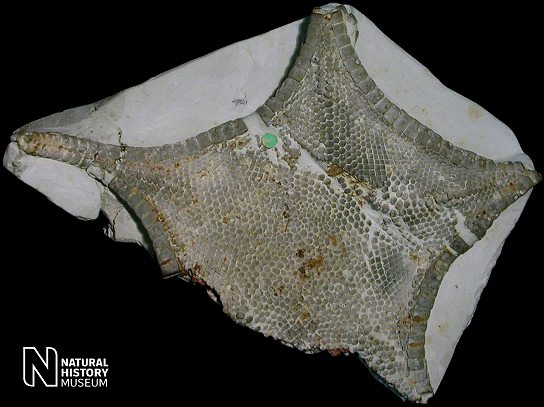
2). Aboral surface of a large and exquisitely preserved individual; x1.1, Grey Chalk, BMNH (British Museum (Natural History) London) E2574. Image © 2005 The Natural History Museum, by kind permission.

3). Detail of a the marginal frame (inferomarginals) showing the highly pitted surface of the ossicles; x4.3, Grey Chalk, Sussex, Capron Collection, BMNH (British Museum (Natural History) London) E3348. Image © 2005 The Natural History Museum, by kind permission.
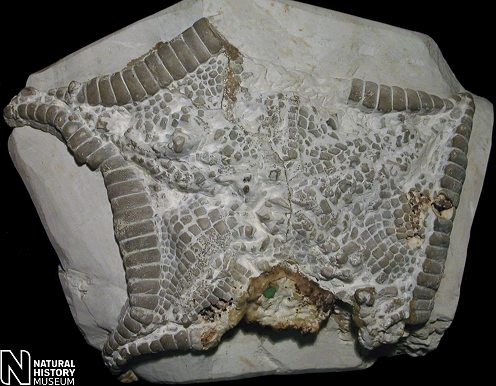
4). Oral surface of a large individual; x1.0, Grey Chalk, Sussex, Capron Collection, BMNH (British Museum (Natural History) London) E3348. Image © 2005 The Natural History Museum, by kind permission.
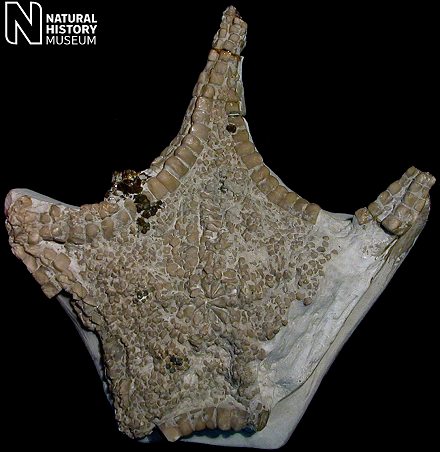
5). Aboral view of well preserved specimen, but lacking many of the aboral ossicles and hence exposing the mouth angle plates; x1.2, Grey Chalk, Dover, Kent, Smith Collection, BMNH (British Museum (Natural History) London) E2602. Image © 2005 The Natural History Museum, by kind permission.
 A
A |
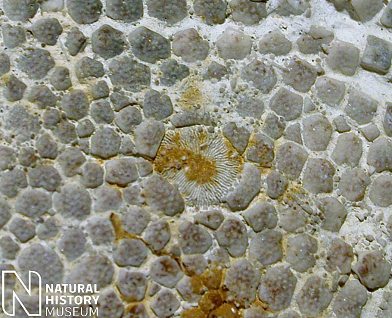 B
B |
6). Details of the aboral surface of an exceptionally preserved specimen focusing on (A) the radials (x5.3) and (B) the madreporite (x5.5); Grey Chalk, BMNH (British Museum (Natural History) London) E2574. Images © 2005 The Natural History Museum, by kind permission.
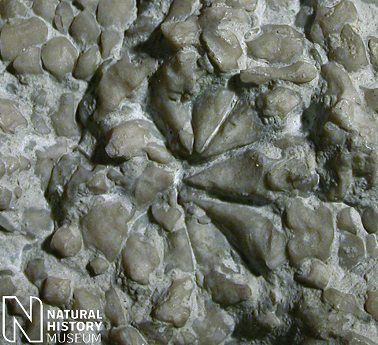
7). Aboral detail of an individual where the aboral ossicles are absent, giving an 'inside' view of the mouth angle plates of the oral surface; x5.7, Grey Chalk, Dover, Kent, Smith Collection, BMNH (British Museum (Natural History) London) E2602. Image © 2005 The Natural History Museum, by kind permission.

8). Aboral surface of an isolated but exquisitely preserved arm; x2.0, Grey Chalk, Dorking, Surrey, BMNH (British Museum (Natural History) London) E3346. Image © 2005 The Natural History Museum, by kind permission.
 |
9). Lateral (side) view of a complete arm; the steeply upturned nature of the arm-tip is typical of Calliderma smithae (x1.6, Willett Collection, Booth Museum, BMB 009683, by kind permission of John Cooper).
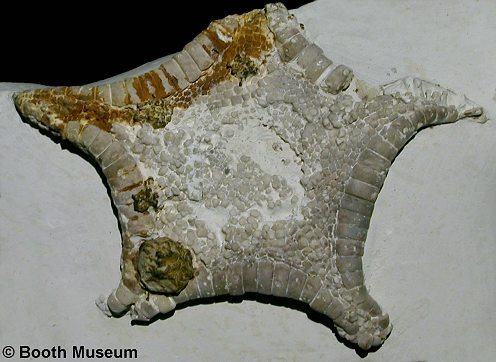
10). Oral surface of a near-complete specimen with overgrowths of pyrite (x1.3, 'Amberley', Sussex, from the Willett Collection, Booth Museum, BMB 007816, by kind permission of John Cooper).
 |
11). Oral surface of an individual with most of the arm-tips broken away (x1.2, Willett Collection, Booth Museum, BMB 007682, by kind permission of John Cooper).
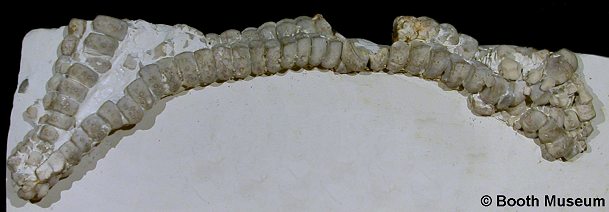
12). Part of a very large individual (x1.1, Clayton Tunnel, near Brighton, East Sussex, from the Willett Collection, Booth Museum, BMB 007815, by kind permission of John Cooper).
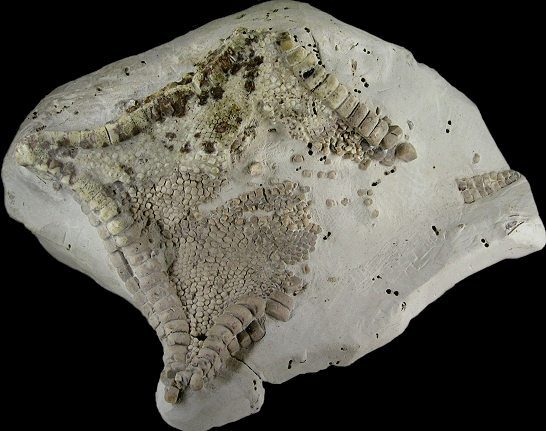
13). A well preserved but beach-weathered specimen (x1.1, Grey Chalk, Akers Steps, east of Samphire Hoe, near Dover, Kent, Private Collection).
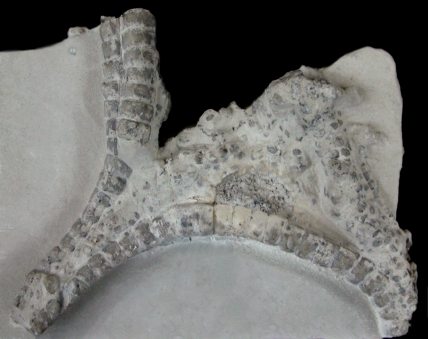 |
14). Part of a well preserved individual; oral view (x1.3, near Cow Gap, Eastbourne, L. R. Strevens collection).
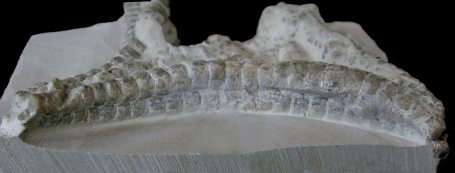
15). Lateral view of the above specimen (Fig. 14).
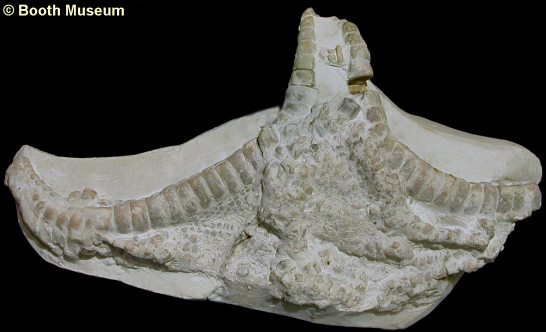
16). Part of a large individual, oral view (x1.1, Willett Collection, Booth Museum, BMB 009683, by kind permission of John Cooper).
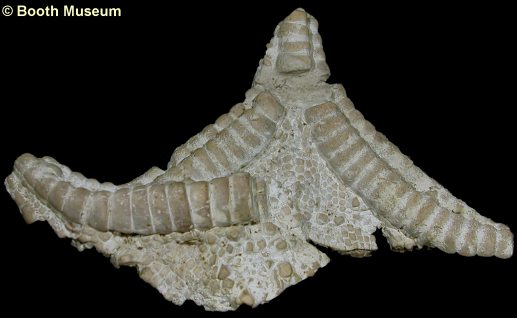
17). An unusual specimen, where the oral surface (bottom left) has flipped back over the aboral surface (x1.2, 'Amberley', Sussex, from the Willett Collection, Booth Museum, BMB 007813, by kind permission of John Cooper).

18). Detail of an exceptionally preserved section of the oral surface (x3.0, Willett Collection, Booth Museum, BMB 007682, by kind permission of John Cooper).

19). Partial semi-articulated specimen (x2.0, Grey Chalk, south of Dover, Kent, in the collection of Keith Little). Image © 2011 Keith Little, by kind permission.